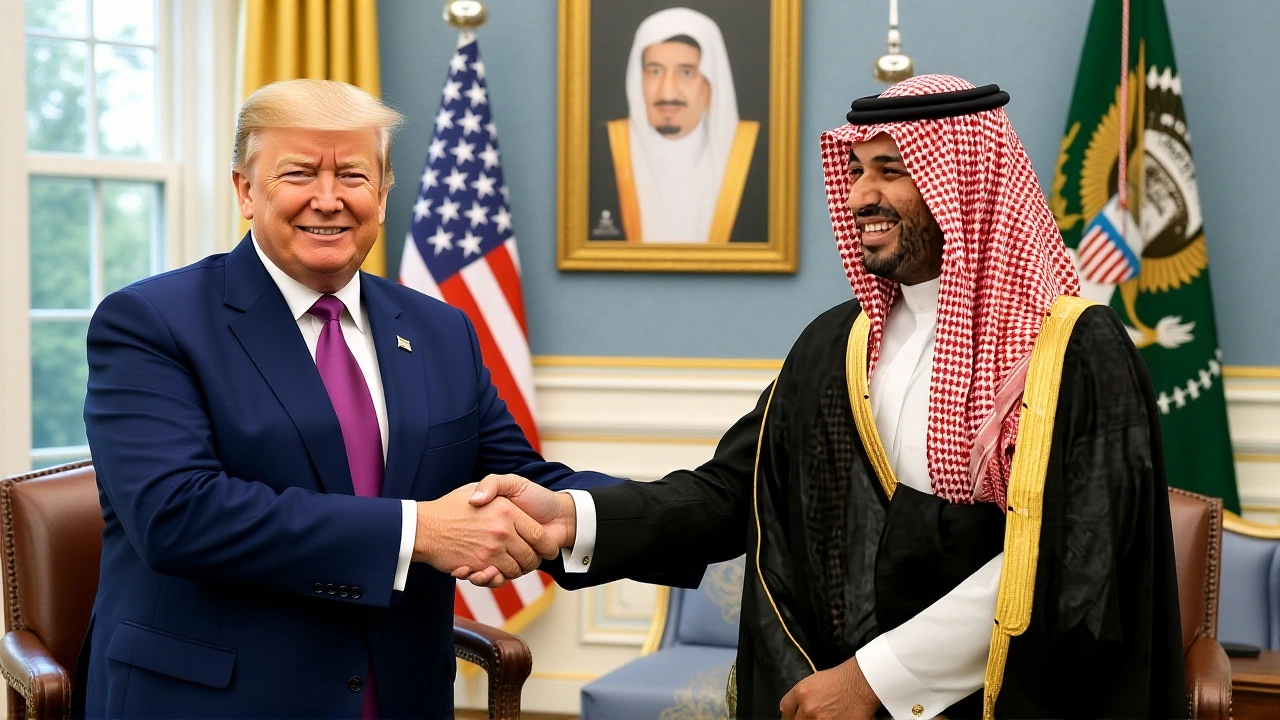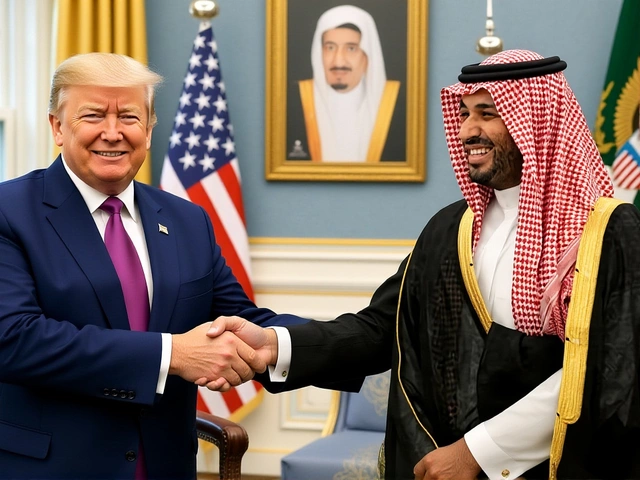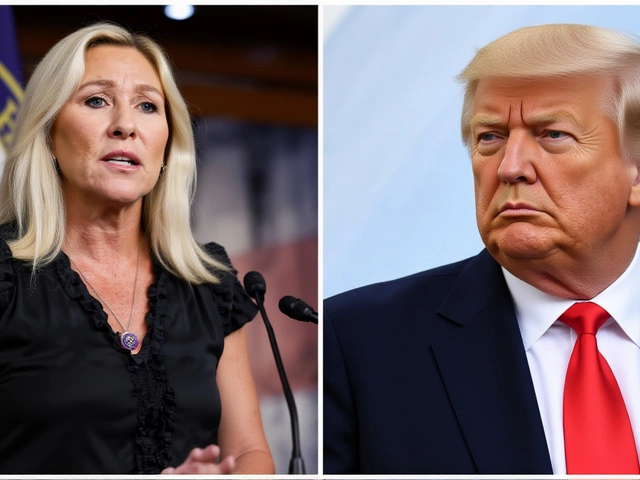On Tuesday, November 18, 2025, Donald J. Trump welcomed Crown Prince Mohammed bin Salman to the White House for a black-tie dinner in the East Room — a rare display of pomp signaling the depth of a new strategic alliance. The visit, which began with the Crown Prince’s departure from Riyadh on Monday, November 17, 2025, culminated in a series of landmark agreements that could reshape the Middle East’s security architecture and turbocharge the U.S. economy. By the time the farewell ceremony ended on the South Lawn that evening, the two leaders had signed the U.S.-Saudi Strategic Defense Agreement, locked in nearly $1 trillion in Saudi investment commitments, and cleared the path for F-35 fighter jet sales that will keep American defense factories humming for years.
A New Chapter in U.S.-Saudi Relations
The U.S.-Saudi Strategic Defense Agreement isn’t just another arms deal. It’s a structural shift. The White House fact sheet called it a "historic agreement that strengthens our more than 80-year defense partnership," but the details reveal something more: a formal reordering of regional power dynamics. For decades, U.S. military presence in the Gulf has been a cost center — expensive, politically fraught, and often unappreciated. Now, under the SDA, Saudi Arabia is explicitly committing to "burden-sharing," meaning it will pay directly for a significant portion of U.S. military infrastructure and operations in the region. That’s a game-changer. It turns a security liability into a revenue stream — and a strategic lever.The agreement also codifies Saudi Arabia’s status as America’s "primary strategic partner" in the Middle East — a phrase that carries weight in diplomatic circles. It’s a quiet rebuke to China’s growing influence and a signal to Iran that its regional ambitions will face a unified front. The timing matters. With tensions rising in the Red Sea and ongoing instability in Yemen, this isn’t just about money — it’s about deterrence. And it’s working: the White House says the SDA "fortifies deterrence across the Middle East," a phrase that military analysts say translates to a more credible threat of U.S. retaliation if aggression occurs.
$1 Trillion in Investment: The Real Economic Bombshell
While the defense deal made headlines, the economic announcement was the quiet earthquake. Saudi Arabia, flush with oil revenues and desperate to diversify, is now pledging almost $1 trillion in U.S. investments — up from the $600 billion secured during Trump’s May 2025 visit to Riyadh. That’s not a rounding error. That’s more than the entire GDP of Switzerland. The funds are earmarked for critical minerals, nuclear energy, artificial intelligence, and defense manufacturing — sectors where the U.S. has technological advantages but lacks capital and scale.Here’s the kicker: this isn’t speculative. The White House fact sheet confirms these are binding commitments, backed by sovereign wealth funds and state-backed entities. Think Tesla gigafactories in Texas, uranium enrichment plants in New Mexico, AI research hubs in Virginia, and defense supply chains stretching from Alabama to Arizona. The administration claims these deals will "create high-paying American jobs" — and they’re not bluffing. A single nuclear energy partnership alone could generate 12,000 direct jobs, according to a 2024 Energy Department analysis. Multiply that across sectors, and you’re looking at well over 100,000 jobs, many in swing states like Pennsylvania, Ohio, and Arizona.
And then there’s the F-35 deal. The U.S. is approving future deliveries of stealth fighter jets to Saudi Arabia — a move previously blocked under Biden due to human rights concerns. Trump’s decision isn’t just about sales; it’s about locking in long-term maintenance contracts, spare parts, pilot training, and software upgrades — all of which flow back to U.S. contractors like Lockheed Martin and Raytheon. The White House says this will "strengthen the U.S. defense industrial base," and they’re right. Every F-35 sold abroad means more production lines stay open at home, preventing the costly shutdowns that have plagued other defense programs.

Why This Matters Beyond the Headlines
The visit didn’t just focus on defense and money. Officials confirmed that discussions on Saudi-Israeli normalization were "active and constructive." That’s huge. For years, the Saudi leadership has held back from normalizing ties with Israel — not out of ideological opposition, but because they needed a political cover. Trump’s offer of advanced weapons and a formal U.S. security guarantee may be just that cover. If Riyadh moves toward normalization, it could trigger a cascade: Jordan, Egypt, and even the UAE might follow, fundamentally altering the geopolitical map of the Middle East.And let’s not forget the nuclear angle. The SDA includes provisions for U.S. firms to help Saudi Arabia develop civilian nuclear energy — under strict safeguards. That’s a delicate dance. While the U.S. insists it’s only for power generation, the technology could, in theory, be diverted. But the administration’s response is simple: if Saudi Arabia wants nuclear energy, they’ll get it under American oversight, not Russian or Chinese. That’s a win for nonproliferation — and a strategic win for U.S. influence.
What Comes Next?
The agreements are signed, but implementation is the real test. The $1 trillion in investments won’t flow overnight. It’ll take years of regulatory approvals, construction permits, and workforce training. But the momentum is real. The White House says the deals will "deliver massive returns for American workers and families for decades to come." That’s not empty rhetoric. The infrastructure bill passed in 2024 already allocated $80 billion for critical minerals processing — and now Saudi capital will fill the gaps.Expect Congress to debate the F-35 sale in early 2026. Some Democrats will push back, citing human rights. But with the defense industry lobbying hard and key swing-state jobs on the line, the vote could be closer than expected. Meanwhile, Riyadh will likely announce its first major AI joint venture with a U.S. tech firm by March 2026 — possibly with Nvidia or Microsoft. And if Saudi-Israeli talks progress, we could see a surprise summit in Washington by mid-year.

Historical Context: A Relationship Reborn
The U.S.-Saudi alliance began in 1945, when Franklin Roosevelt met King Abdulaziz on a Navy cruiser in the Suez Canal. It was built on oil and security. For decades, it was transactional — U.S. protection in exchange for steady oil exports. But under Trump, it’s becoming a partnership of mutual economic ambition. The $600 billion deal in May 2025 was the first crack in the old model. The $1 trillion deal in November 2025? That’s the dam breaking.This isn’t just about Trump’s presidency. It’s about a new template: security tied to investment, not just oil. Other Gulf states are watching. If this works, expect similar deals with Qatar, the UAE, and even Oman. The U.S. is no longer just the world’s policeman — it’s becoming the world’s most sought-after economic partner.
Frequently Asked Questions
How will the $1 trillion investment affect American workers?
The investment is targeted at high-tech sectors like nuclear energy, AI, and defense manufacturing — industries that pay above-average wages. A 2024 Congressional Budget Office study found that every $1 billion in foreign direct investment in these sectors creates 1,200–1,800 jobs, mostly in manufacturing and engineering. With $1 trillion, that’s up to 1.8 million job-years of economic activity over the next decade. Many of these positions will be in swing states like Pennsylvania, Ohio, and Arizona, making them politically significant.
Why is the F-35 sale controversial?
The F-35 is the most advanced fighter jet in the world, and its sale to Saudi Arabia raises concerns about technology transfer and regional arms races. Critics point to Saudi Arabia’s human rights record and involvement in Yemen’s war. But supporters argue that keeping Saudi Arabia armed with American-made weapons ensures U.S. control over maintenance, software updates, and operational use — unlike Chinese or Russian alternatives. The White House insists the jets will come with strict end-use monitoring.
What’s the connection between this deal and Saudi-Israeli normalization?
Saudi Arabia has long conditioned normalization with Israel on Palestinian statehood. But with the U.S. now offering advanced defense capabilities and a formal security guarantee, Riyadh may feel less vulnerable. If Saudi Arabia normalizes ties, it could trigger a domino effect across the Arab world, isolating Iran and reducing the need for U.S. boots on the ground. The White House sees this as a strategic multiplier — less military spending, more diplomatic leverage.
How does this compare to past U.S.-Saudi agreements?
Previous deals, like those under Obama or Bush, focused on oil security and counterterrorism. This one is different: it’s economic, technological, and structural. The $600 billion pledge in May 2025 was already unprecedented. The $1 trillion expansion, tied to AI and nuclear energy, marks a shift from energy dependence to technological interdependence. It’s less about pumping oil and more about building the future — together.
Is the U.S. risking its credibility by selling weapons to Saudi Arabia?
It’s a risk — but one the administration calculates is worth taking. The U.S. has sold weapons to Saudi Arabia for decades. What’s new is the level of oversight and the explicit linkage to burden-sharing. The SDA requires Saudi Arabia to fund U.S. military operations in the region, which reduces taxpayer costs. Additionally, the U.S. retains control over software and maintenance, limiting potential misuse. The trade-off is geopolitical influence: by staying deeply embedded in Saudi defense, the U.S. gains more leverage than it would by walking away.
What’s the timeline for these agreements to take effect?
Defense contracts and F-35 deliveries will begin within 12–18 months, with full implementation over 5–7 years. The $1 trillion investment will roll out in phases: $200 billion in the first two years, with the rest tied to milestones in nuclear licensing, AI infrastructure, and critical minerals processing. The White House expects the first major joint venture — likely in AI or uranium enrichment — to be announced by March 2026.


